Chrysanthemums make a bright, pleasant addition to any garden, but you may be surprised to learn how easy they are to grow. Although you commonly propagate mums from cuttings or divisions, seeds. However, seeds should be started at the right time of the year and kept under appropriate conditions to perform at their best.
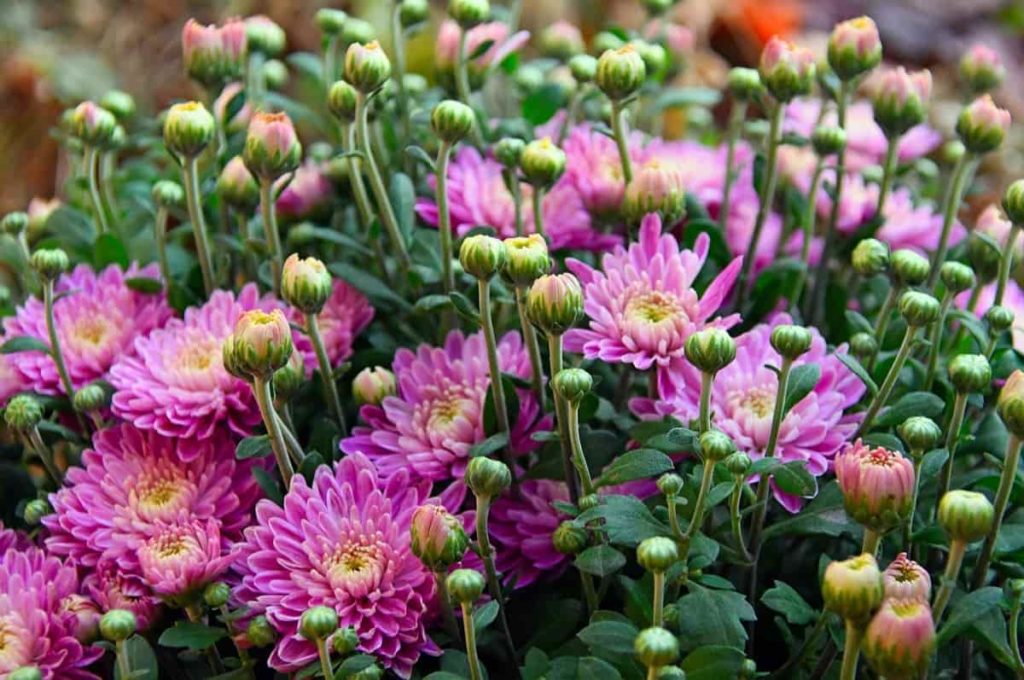
You must sow seeds at the appropriate time of year and store them in the appropriate environment. The most commonly grown Chrysanthemum varieties are hybrids or cultivars propagated using cuttings or divisions, so they rarely produce seeds. However, they can occasionally produce seeds that can be collected and used to grow new plants, although plants may not have flowers that look like the parent plant.
How to grow Chrysanthemums from seed to harvest
Growing Chrysanthemum from seeds
- Garden mums are short-day plants and initiate flower buds in response to the interaction of day length, temperature, and plant age. On average, garden mums won’t start setting buds until the nights are about 10 hours long.
- When grown from the seed, Chrysanthemum seeds need up to 16 weeks to flower. Most growers starting seeds indoors before all possibilities of frost have passed is the best choice. Chrysanthemum is only three to four years old, and although it may last longer, it will become more susceptible to winter damage with each passing year.
Harvesting Chrysanthemum seeds
- Leave some healthy flowers on the plants until they begin to wilt and die. If you want to collect dead flowers quickly, wait until the stem under the flower’s head turns brown.
- Place the spent flower on a white paper, one at a time, slowly squeezing each bloom with your fingers. Do not pick the heads of the green seeds, as the seeds will not finish ripening after being removed from the plant. Snip off the mum seeds with cutting shears and separate them, spreading the seeds on a sheet of paper towel so that they dry for a day or two before storing them in an airtight jar.
- You should Keep your seeds in a warm, dry place outside of strong wind and direct sunlight for 2 to 3 days until they are completely dry. You can now store the seeds in a regular white paper envelope or plastic zip lock bag and then label it.
Harvesting stage of Chrysanthemum
- Good harvesting depends on the cultivar, marketing, purposes, etc. Flowers are harvested three months from the planting date at four days. Fully open flowers are plucked with or without a peduncle for decoration and garlands.
- Standard varieties of flowers are harvested when 2 to 3 rows of radial flowers are vertical to the flower stalk. Flowers are loosely packed in bamboo baskets or gunny bags and sent to retail markets for sale.
In case you missed it: How to Grow Marigold Flowers from Seed to Harvest: A Planting Guide for Beginners
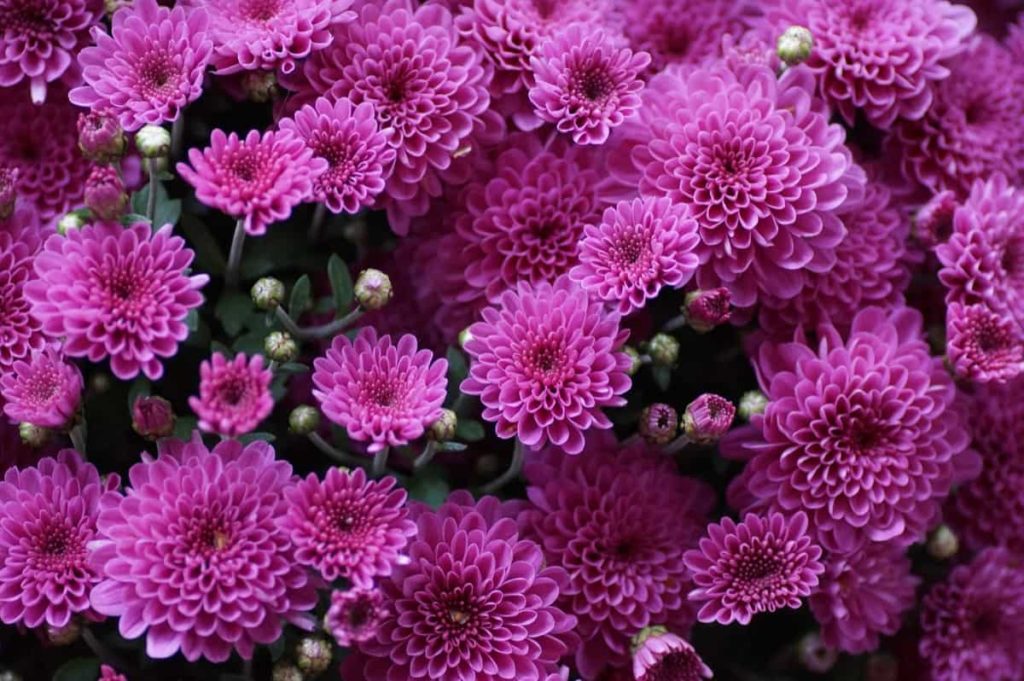
Encouraging flowers in Chrysanthemum
Chrysanthemum can grow in moist but well-drained soil with added compost or well-rotted manure in a sunny, sheltered spot. All Chrysanthemums require stacking. You can encourage flowers on mums by removing the initial buds with pruners. Cut the growth of the tops back into the growth area of the following branches, and the plant will produce more stems and larger, more profuse buds.
Best time to plant Chrysanthemum seeds
- The best time to start from seeds is by sowing indoors in early spring. You should start the seeds about eight weeks before the last spring frost, which is about mid-February. Seeds can also be started outdoors, from the last spring frost to two months before the first autumn frost.
- Early flowering Chrysanthemums can be planted on ornamental borders and will flower from late summer to autumn. Late-flowering Chrysanthemums flower and are grown as houseplants. Choose hardy garden types for a reliable perennial Chrysanthemum that can be left in the ground throughout the year.
- For the annual Chrysanthemum, seeds are sown from June-July for rain-season flowers, and seeds are sown in September for winter flowers. The rainy season is also a perfect time for flower enthusiasts to prepare for one of the most spectacular winter flowers, Chrysanthemums. It’s an herbaceous perennial that spectacularly survives the winter cold in late November and early December.
The best fertilizer for Chrysanthemum
- Like most gardeners, you can use a granular application with a 6-2-4 or 4-2-3 analysis to fertilize your mum plants. And this rate should be 450 grams per 100 square feet of the garden bed.
- When growing plants, feed with high nitrogen fertilizer as the flower buds appear to transform into high potash feed. Soluble fertilizers are also helpful. They are mixed with water on the manufacturer’s instructions and applied to the plant’s root zone. For this feeding method, use a 20-20-20 or 15-15-15 balanced nutritional solution.
- Fertilize mums in the spring when their new growth appears. Water the plants with soluble, balanced fertilizers, such as 10-10-10 mixtures, once per month. Dilute the fertilizer in water at the recommended rate on the fertilizer label.
- It is necessary to provide nitrogen and potassium to Chrysanthemums during their vegetative phase. Feeding plants before flower buds form promotes healthy roots, bud growth, and a vigorous plant. Depending on your zone, start the feeding cycle from March to May.
Do Chrysanthemums like full sun?
- Mums are sun-loving plants and prefer exposure to the sun for at least 6 hours daily. Choose a place with well-drained soil for your mum.
- Whether your growing mums in a pot or garden, they love light. Mums thrive in full sun conditions if you give them enough water. Choose a place with at least six hours of sunlight daily. If the mums don’t get enough sunlight will be leggy and produce fewer, smaller flowers.
- Chrysanthemums are sun-loving plants. Although they technically only need 6 hours of sunlight daily, the lighter they receive, the better their growth, blooming, and hardiness. A little shade on warm summer afternoons is suitable in warm gardening areas to avoid scorching.
- Mums need 6 hours of sunlight daily. Chrysanthemums are sun-loving perennials that love full-sun conditions. If the Chrysanthemum gets less than 6 hours of sunlight, its flowers will not be as strong as they can be with extra time in the sun.
Growing Chrysanthemum indoors
- Chrysanthemums perform well in average temperatures offered indoors. They prefer slightly cooler areas, 10°C to 18°C. Chrysanthemums enjoy moist soil, so water them frequently.
- Water your pot mums at least every other day. Water on the soil surface (plant base) and not on top of plants. Mums are spectacular autumn plants that can be brought indoors and used for decorating. Taking care of mums indoors is easy, and with just a few tips, you can keep the mum’s plant healthy for three to four weeks.
In case you missed it: How to Start a Terrace Garden from Scratch in Pune/Maharashtra: For Vegetables, Fruits, Flowers, and Herbs
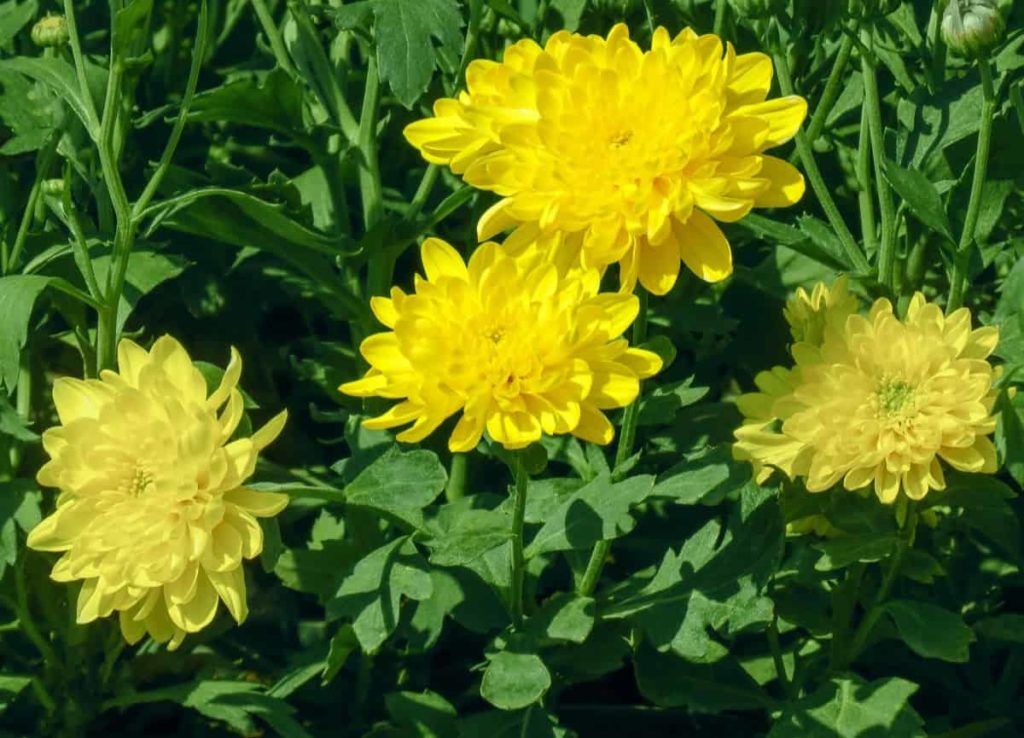
Will Chrysanthemums root in water?
You can propagate the Chrysanthemums from the cutting by rooting them first in the water or planting them directly in the potting mix. The Mum cutting can be rooted in water or soil. If you root them in water, you should place them in a small, waterproof container, such as a jelly jar, juice glass, or small vase. You should add about 1 inch of water to the container, ensuring the remaining leaves are above the water level.
Why are my Chrysanthemum not flowering?
- If you plant them in locations offering less than six hours of direct sunlight, mums stop blooming. Even more so, underwater or soggy soil can cause pests, diseases, and root rot that inhibit flower growth. Finally, forgetting to pinch mums in the spring can also affect the blooming.
- If your plant is well-fed and gets plenty of water, it will have fuel to produce all those bright flowers. Feed the plants in the early spring until every two weeks, and buds have formed. You can also enhance blooming by removing spent flowers, called deadheading.
How much space do Chrysanthemums need?
- Set them at a distance of 18 to 36 inches, depending on their expected size at maturity. Mums need good air circulation. Put the mums in the ground at the same depth as they were in the pot. If planted too low, the water can accumulate around the base and rot the stems. Check your mixture before potting. Most garden mums are grown with an 8-inch mum pan or a rooted cutting planted in a container of a similar size.
Pruning Chrysanthemums
- Chrysanthemums are reliable perennial plants that probably grow in almost every garden. After Chrysanthemum plants bloom, you should cut them within six inches of the ground. Then if you want to divide them, you can dig up the clumps and cut the roots.
- Chrysanthemums don’t need pruning, but they must be pinched in the growing season. This will allow your plants to grow out of the branch and thrive. When your plant is about fifteen centimeters tall, pinch just an inch away from each shoot.
- After blooming, cut the stems about 8 inches long. Or wait until spring and cut off dead stems and leaves when new growth begins to emerge. Transplanting can be done in spring or autumn.
- Pinching the Chrysanthemum is one of the important actions in culture. Pinching refers to removing the growing tips of plants to promote the lateral growth of plants. It reduces plant height, promotes axillary branching, and delays flowering.
- Remove the side shoots so the plant grows a single stem. Half-hardy, early flowering Chrysanthemums can be cut back to the ground in the fall and left in the garden in the winter.
In case you missed it: How to Start Backyard Gardening in Sydney: A Guide for Growing Vegetables, Flowers, Fruits, and Herbs at Home in Australia
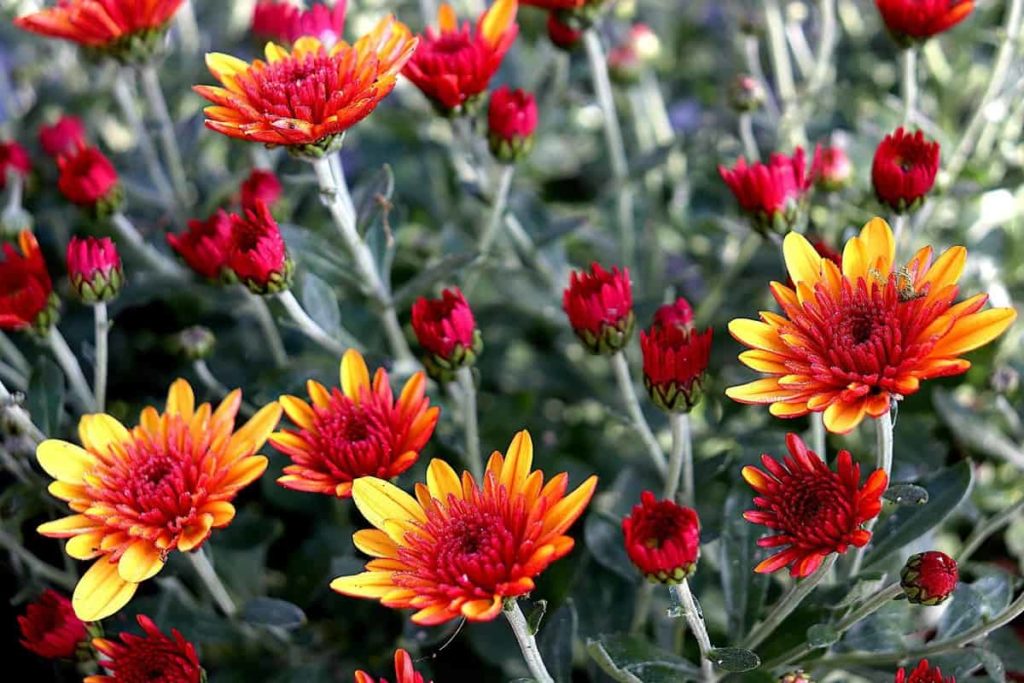
Growing Chrysanthemum from cutting
- Remove the leaves on the lower half and insert the cutting into a flat or pot with moist perlite. Insert the cutting into the perlite until its first leaves. A rooting hormone can be used to accelerate root formation. However, roots will form without them.
- Count three nodes and cut at the top. You should dip the lower end of the cutting into the rooting hormone, then carefully insert it into a small pot filled with a moist, soilless potting mix. You should cover the small plant with a plastic bag and moisten the soil. Be patient, and don’t try to transplant until the roots grow.
- Chrysanthemum cutting will root in 3 to 4 weeks. When the roots are 1 to 1 1/2 inches long, remove the cuttings and plant them in small pots that contain fresh potting soil, or plant them directly in the garden.
Water requirement for growing Chrysanthemum
- It is essential to prevent the plant from drying or wilting too much between the waterings. If the mum is in a very hot place, watering the plant well once a day should be enough. When watering, instead of pouring water through dense flowers, water the plant’s soil.
- Mums don’t like to dry between water, so ensure you water them at least every other day, especially if they wilt. Like potted mums, water them on the surface of the soil instead of on top of the blooms. Watering the leaves can cause disease.
- Chrysanthemums love the full sun, and this heat means they also need plenty of water. Give them a nice soak after potting again, then water them every other day or whenever the soil dries out.
Growing Chrysanthemums in pots
- You can grow Chrysanthemum indoors in pots. These plants can thrive when planted, which can be a great way to protect them from cold and other harsh winter conditions.
- Mums work best in well-drained soil, so use potting mixes in your container. If you’re growing mums in pots for the same season, you can mix them with other plants in a large container.
- Chrysanthemums growing in pots is an excellent garden solution for small gardens. Most garden mums grow from 2 to 3 feet in size and need a minimum of 12-inch containers for the best support. Rich potting soil with good drainage stimulates root growth and water container mums from the bottom of the container.
- It is challenging to get a potted mum to bloom again, and the plants are usually discarded when their beauty is lost. However, you can move the plant to a new container with fresh potting soil, prolonging the plant’s life.
- Until the conditions are suitable for transplantation, you can keep them in containers indoors. They grow best in nutrient-rich soil. It is recommended that the fertilizer be applied before planting Chrysanthemums.
- Chrysanthemums in pots are an excellent garden solution for growing apartments and small gardens. Most garden mums grow in size from 2 to 3 feet and require a minimum of 12-inch containers for best support.
In case you missed it: Growing Kiwi Fruits from Seeds

Winter care for Chrysanthemums
- It’s easy to overwinter Chrysanthemums, dig the plants, and cut all the stems by about 6 inches. Place Chrysanthemums in a box or tray, cover them with soil or fertilizer and store them in a cool, frost-free place for winter.
- Most garden mums should be able to withstand the mild autumn frost. To keep the plant attractive and healthy, cut down any dead flowers as soon as they wilt.
- Fewer stems will grow next year if you cut mums back to the ground. Then, providing a heavy layer of mulch on the plant is better after the ground is frozen. Mulch can be straws or leaves for wintering mums.
Why are my Chrysanthemums leggy?
- Chrysanthemums are full-sun plants. If the amount of shade they get is increased, it will cause legginess. Also, much nitrogen in fertilizer will contribute to legginess. Many types of mums need to divide every few years to keep them strong.
- You should place in a full-sun location that receives at least six hours of direct sun daily. Those that require full sunlight planted in shaded areas often expand for more sunlight and grow faster. Chrysanthemums prefer well-drained and slightly moist soil.
Soil requirement for growing Chrysanthemum
- You should plant Chrysanthemums in well-prepared, fertile, loamy, or sandy soils where they get at least five to six hours of early morning sun daily. Dig holes at least twice the size of the root ball and add compost or peat to help with drainage. Chrysanthemums benefit from a light and frequent feeding with a balanced fertilizer during the growing season.
- Like many other perennials, mums prefer well-drained yet moist soil slightly rich in acid and organic matter. For growing Chrysanthemum, well-drained sandy loam of good texture and aerated soil is best. Mums need neutral or slightly acidic soil with a pH of 6.5 to 7.0 and high organic content. Very light sandy soils are not recommended due to their poor moisture content.
- Chrysanthemums can survive in most soils but thrive in well-drained soils with constant moisture. Hard, dry soil prevents the roots from being well established, while wet, soggy soil sinks the roots.
How deep should mums be planted?
Mums have shallow roots, and they don’t like competition. Plant about 1 inch deeper than them in a nursery pot, being careful with the roots as you spread them. Water new plants well, and take care not to let them wilt. When the bottom leaves appear to wilt or begin to turn brown, water more often. Chrysanthemum roots are shallow, so they don’t like competing with weeds. Plants planted in the spring should get 5-10-10 fertilizer once or twice a month until the cold season begins.
In case you missed it: How to Grow Hibiscus from Cuttings to Harvest: Steps to Planting and Care
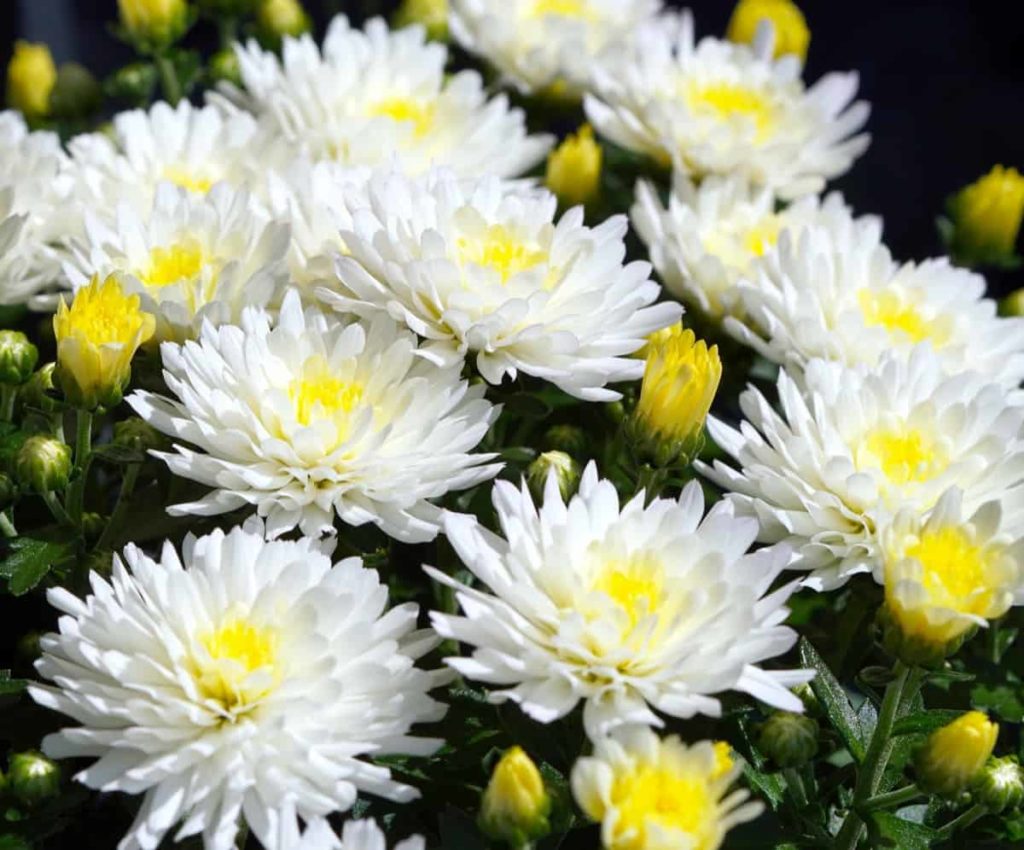
Germinating Chrysanthemum seeds
- Mums are easy to grow and can be propagated in various ways. Growing from seeds is easy and can prove to be quite adventurous due to the uncertainty of the type of bloom. Due to the long growing season necessary for mum seeds, you should start indoors six to eight weeks before the last frost date. Or you can sow the seeds in a well-prepared bed in the spring.
- Although mums grow easily from seeds, they cannot produce a plant that resembles the parent plant in flower color, texture, or growth habit. Most seeds are propagated only to create new mum varieties, which is not beneficial for home gardeners.
- Light exposure is the key to successfully germinating mum seeds, so they should be sown at an appropriate depth. You should sow two or three seeds in each pot by lightly pressing them to the soil surface. You should spread a thin layer of soil on top so they are covered but still somewhat exposed to light.
- You should place seed trays near bright south or west windows or provide extra light using fluorescent grow lights. Suspend the 12 to 15-inch lights on top of the seed tray. Keep the soil evenly moist until the mum’s seeds sprout, which should occur in 10 to 15 days. Thin seedlings soon follow their first set of true leaves.
Conclusion
If you plan to grow Chrysanthemums from seeds, you can start them indoors in a seed tray in early spring, then transplant them to the garden after the last frost. That way, they’ll already have a few weeks to germinate and grow, which will allow you to enjoy blooming in a short time after they are in your flower beds. It’s also important to note that there may be some unexpected color variations when growing mums from seeds, so if you’re particular about what color you want in your garden, you may be better off growing mums with cutting or potted plants.
- How to Grow Hibiscus from Flower
- Plantation Ideas for Home Decoration: A Beginners Guide
- Flower Garden Designs and Layouts for Beginners
- Planting and Spacing Techniques in Papaya: A Beginner’s Guide
- Growing Gold: Essential Techniques for Planting Pineapples
- How to Make Kalanchoe Plant Bushy: Home Remedies and Solutions
- 11 Reasons Why Your Gardenia is Not Blooming: Home Remedies and Solutions
- Eco Elegance: The Guide to Designing a Drought-Tolerant Landscape
- Gardening on a Slope: Strategies for Hillside Landscaping
- Nourish and Flourish: Top Organic Mulches for Thriving House Plants
- Everything You Want to Know about Indian Mogra Flower: Discover Uses and Growing
- Green Thumb Success: Expert Tips for Cultivating Greenhouse Pumpkins All Year Round
- Maximize Growth & Flavor: The Ultimate Guide to Companion Planting in Herb Gardens
- How to Control Rhododendron Problems Naturally: Home Remedies and Organic Ways to Fix Them
- Natural Magic: The Remarkable Benefits of Cinnamon for Plants
- Best Steps to Revive Dying Tulip with Natural and Organic Treatment
- 10 Reasons Why Your Angel Trumpet is Not Blooming: Remedies and Treatment
- How to Fix Periwinkle Leaf and Flower-Related Problems: Natural Remedies and Solutions
- How to Fix Zinnias Leaf and Flower Problems: Discover Natural and Home Remedies
- Organic Steps to Induce Lemon Tree Flowers: A Comprehensive Guide
- Bloom Booster: Crafting the Perfect Homemade Bougainvillea Fertilizer
- Optimizing Growth: A Guide to Applying NPK Fertilizer for Potted Plants
- 10 Best Homemade Fertilizers for Rubber Plant: DIY Recipes and Application Method
- How to Boost Female Pumpkin Flowers: Effective Steps for More Flowers and High Yields
- Transform Your Indoor Garden: Top Benefits of Pink Salt for Houseplants
- 10 Best Homemade Fertilizers for Peacock Plants (Calathea): Easy DIY Guide
- Unlock Blooms: 9 Reasons Why Your Potted Chrysanthemum is Not Blooming
- 8 Reasons Why Your Potted Hibiscus is Not Blooming: Fix it with Simple Solutions
- Unlock Blooms: 9 Key Reasons Your Potted Frangipani Won’t Flower
- 10 Reasons Why Is My Ice Plant Not Blooming: Remedies and Treatment
- 10 Reasons Why My Potted Hydrangea Not Blooming: Treatment and Remedies
- 10 Reasons Why is My Wisteria Not Blooming: Remedies and Treatment
- 10 Reasons Why is My Goldfish Plant Not Blooming: Remedies and Treatment
- Maximize Your Space: Ultimate Guide to Balcony Gardening with Grow Bags
- 10 Reasons Why Your Iris is Not Blooming: Remedies and Treatment
- 10 Reasons Why Your Anthurium Plant is Not Blooming: Treatment and Remedies